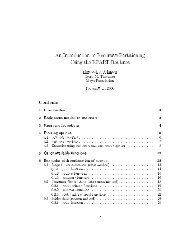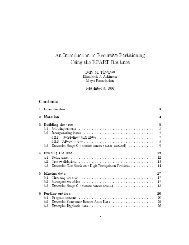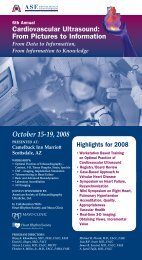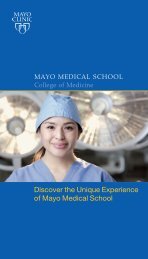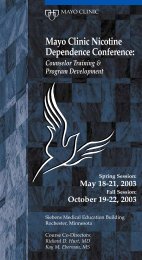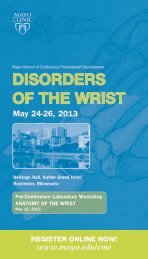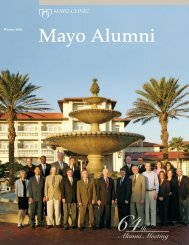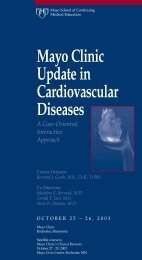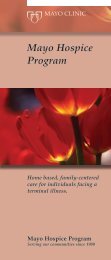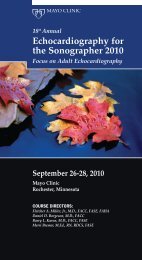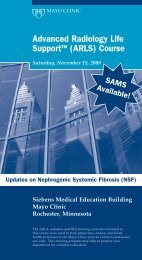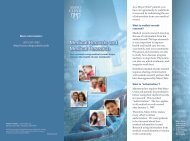current issue - Mayo Clinic
current issue - Mayo Clinic
current issue - Mayo Clinic
You also want an ePaper? Increase the reach of your titles
YUMPU automatically turns print PDFs into web optimized ePapers that Google loves.
??<br />
overwhelming,” says Dr. Martin. “The experience of setting<br />
up clinics in settings from county buildings to baseball fields<br />
to care for thousands of people in distress reminded me of<br />
why I went to medical school in the first place.<br />
“I thought about my experiences and whether there<br />
were new ways for me to use my research training to help<br />
people. Ultimately, I decided to pursue work in global<br />
environmental health, using the research tools<br />
that I had developed over my career. Six<br />
months after Hurricane Katrina, I had again<br />
joined NIH, the one place I knew had<br />
the resources to build new programs<br />
in global health that could really<br />
change the lives of vulnerable and<br />
underserved populations around the<br />
world.”<br />
Today, Dr. Martin is associate<br />
director of the Eunice Kennedy<br />
Shriver National Institute of Child<br />
Health and Human Development, one<br />
of 20 institutes at the NIH. His office is<br />
focused on disease prevention and health<br />
promotion, especially related to the early life<br />
origins of childhood and adult disease and the<br />
development of novel approaches to prevent<br />
these disorders before they become clinically<br />
apparent.<br />
William J. Martin II, M.D.<br />
Reflecting on the value of research training<br />
Dr. Martin recalls the enthusiasm of discovery he felt in his<br />
first research project at <strong>Mayo</strong> <strong>Clinic</strong> and its significance in<br />
his life. “I believe the value of research training is that it leads<br />
to lifelong learning and adapting to solve new, important<br />
challenges,” he says. “I started down that path at <strong>Mayo</strong> and,<br />
more than three decades later, I find myself as excited<br />
and enthused as ever in my career. The research<br />
challenges seem more daunting but more<br />
important than ever before.”<br />
Dr. Martin lives and works in<br />
Bethesda, Md., and returns to the<br />
Rochester area several times a year<br />
to visit family, including his sister,<br />
Mary Jo Martin, and his mother,<br />
Mary Adams Martin, who worked as<br />
a social worker in the Department of<br />
Psychiatry and Psychology at <strong>Mayo</strong><br />
<strong>Clinic</strong> for almost 20 years. Both women<br />
live at Charter House.<br />
“<strong>Mayo</strong> was everything in my career,”<br />
he says. “<strong>Mayo</strong> provides outstanding clinical<br />
training and permits those so motivated to<br />
pursue unique career paths, be it in research,<br />
education or clinical medicine. I’m grateful for<br />
the many doors opened for me because of my<br />
association with <strong>Mayo</strong> <strong>Clinic</strong>.”<br />
Seeking solutions to burning questions<br />
In the last seven years at the NIH, Dr. Martin has worked<br />
with partners across the U.S. government, from the<br />
Environmental Protection Agency to the Department of<br />
State, to help improve air quality in developing countries.<br />
This work has focused on reducing indoor air pollution in<br />
households of people in extreme poverty who burn biomass<br />
fuels or coal for cooking. This simple daily activity results<br />
in such intense smoke within homes that it is the No. 1<br />
environmental cause of death in the world.<br />
“Governments and organizations around the world<br />
desperately need answers to key research questions to<br />
develop interventions, with new clean-burning technologies,<br />
for tens of millions of households,” he says.<br />
Research fellowship during ‘glorious’ era<br />
of GI program paved way for future leader<br />
in the field<br />
Fernando Azpiroz, M.D., Ph.D., ventured to <strong>Mayo</strong> <strong>Clinic</strong><br />
in Rochester in 1982 to pursue more specialized training<br />
and research experience after his residency in general surgery<br />
at the San Carlos University Hospital of Madrid. At <strong>Mayo</strong>, he<br />
completed a three-year fellowship in the Gastrointestinal (GI)<br />
Research Unit and received the Kendall Award for research<br />
focused on the muscular activity of the stomach and the way<br />
the stomach handles food.<br />
16 <strong>Mayo</strong> Alumni



